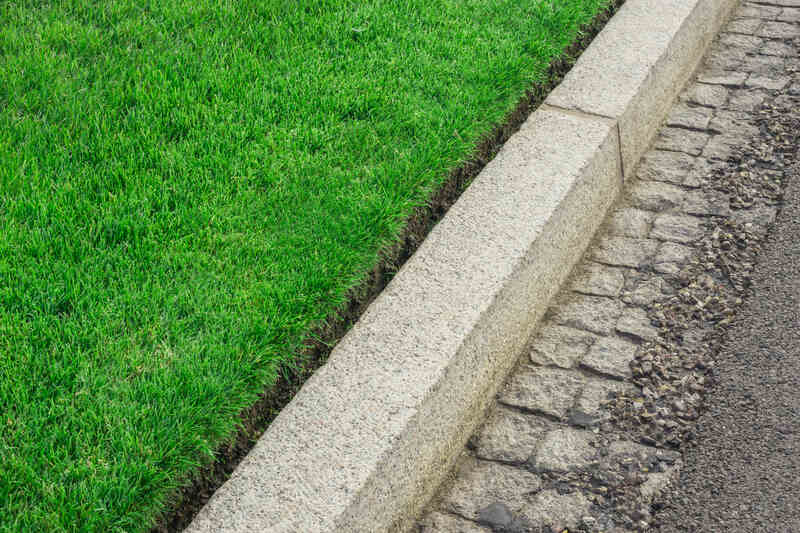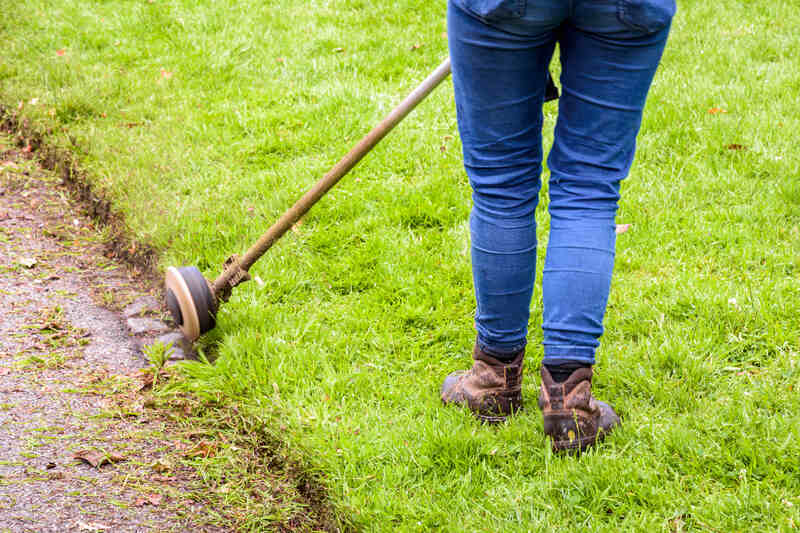
Tired of switching tools just to tidy up your lawn edges? Learning how to edge a lawn with a string trimmer is easier than you think. All you need to do is grab your trimmer, flip it, and find the right angle.
In this article, we’ll guide you through all the steps to achieve clean, sharp lawn edges using just a string trimmer. Plus, we’ll share some common pitfalls and show you how to avoid them.
Edging with a String Trimmer: Step-By-Step
Picture this: you’re finishing up trimming your lawn and notice some grass creeping over onto your flower beds. Instead of stopping to get your manual edger, why not just tilt your string trimmer and edge those invasive blades back into line?
String trimmers (a.k.a weed eaters or weed wackers) are incredibly versatile tools, and learning how to edge a lawn without an edger will make your yard work quicker and smoother.
If you’re new to using a string trimmer as an edger, it might take some practice at first. But, overall, it’s a very simple process.
Here’s what you need to do:
Step 1: Gather the Materials
Before diving in, have all the essentials lined up. Here’s a checklist:
- String trimmer
- Safety glasses
- Long pants
- Closed-toe shoes
- Work gloves (optional)
- Measuring tape or stick (optional)
Tip: Make sure your string trimmer is ready to go. For gas models, check the fuel level through the see-through section of the tank and top it off if it’s low. For electric models, check the battery charge indicator. If it’s low, plug it in to charge as per the manufacturer’s instructions.
Step 2: Mow Your Lawn

Mowing your lawn before edging will make your life a whole lot easier. Cutting the grass shorter, particularly along the edges where you’ll be working, allows you to maneuver the trimmer smoothly and achieve a clean border. Plus, with less grass blocking your view, you’ll be able to see the line you’re creating much more clearly.
For mowing tips, check out our guide, “How to Mow a Lawn the Right Way.”
Step 3: Clear the Area
After mowing, take a few minutes to clear out the area where you’ll be using the string trimmer. Remove any objects that could get in your way while edging or become entangled in the trimmer line. This includes rocks, sticks, toys, hoses, grass clippings, and anything else that shouldn’t be there.
Step 4: Plan Your Edge

With everything cleared away, you’re ready to plan your edge. This step, while optional, is especially helpful if you’re aiming for precision or if it’s your first time edging.
Use a measuring tape or a straight stick to mark a clear, straight line where you want your edge to be. For curved edges, a garden hose is an excellent tool for laying out your path.
Step 5: Prepare the String Trimmer
Next, it’s time to get your string trimmer ready for edging. Here’s how:
- Check your trimmer line: Look closely at the line. Is it frayed or knotted? Make sure there’s plenty to use and it’s in good condition. A worn-out line can break easily and won’t give you the clean cut you’re looking for. If the line breaks mid-task, you’ll have to stop and rethread it, which can be frustrating and time-consuming (but you can learn how in our guide, “How to String a Weed Eater”).
- Adjust the string trimmer head: Flip your trimmer head to a vertical position, making sure the deflector shield is now facing toward you. This is the key to getting that crisp, neat edge along your driveway or garden border.
- Flip your trimmer for better control: Turn your string trimmer upside down so the part that’s usually on top is facing your body. This position lets your thumb easily rest on the trigger. Also, hold the side of the handle instead of the top for steadier control and smoother edging.
Step 6: Start Edging

Now that your trimmer is all set up, you can start tackling your lawn’s edges. To get clean, crisp edges, you need to:
- Ease the line down: If you’re edging along sidewalks, walkways, or patios, slowly lower the spinning line to the ground until it just grazes the surface where the grass meets the edge.
- Find the right angle: Ideally, you want the trimming line to hit the ground at a 90-degree angle for the cleanest cut. If the angle is off, you might end up cutting unevenly or digging too deeply into the soil.
- Start edging: Turn on the string trimmer and let it reach full speed. Then, smoothly guide it along the edge you’re defining.
- Move against the spin: Move opposite to the direction the trimmer line rotates to push the soil and cut grass outward, away from the clean edge you’re creating. If your trimmer spins clockwise, edge from left to right, which will direct debris into your lawn and away from the sidewalk or driveway. If it spins counterclockwise, edge from right to left.
- Keep a steady grip as you edge: Maintain your trimmer level and steady to avoid uneven cuts. This way, you make sure your lawn’s edges are sharp and straight from beginning to end.
- Take small bites: Don’t try to tackle a huge section at once, especially if it’s your first time edging. Focus on trimming small sections at a time, gradually working your way along the edge.
Bonus Tip: Try to always keep the guard on your trimmer head while edging. It’s there for a good reason: to protect you from flying debris like stones, dirt, and bits of the trimmer line that can whip around at high speeds. If you’re having trouble seeing where you’re edging, change your stance or bend a bit instead of removing the guard.
Common Mistakes When Edging with a String Trimmer

Edging with a string trimmer is a straightforward process, but there are a few common mistakes you’ll want to avoid to get that perfect edge and stay safe. These are:
Trimming Line Too Short
A string trimmer line that’s too short won’t provide a clean cut and could strain or overheat the motor. Plus, it doesn’t reach far enough, so you can’t cover as much ground.
The fix: Slow down a bit when you’re trimming. Make sure you’re feeding the line properly so it stays long enough.
Trimming Line Too Long
On the flip side, an excessively long trimmer can snag on objects or even whip around and hit you. Besides, it can cause your trimmer to lose power and mess up your cuts.
The fix: Keep an eye on how your trimmer’s doing and the quality of your cuts. If things aren’t going smoothly, switch off the trimmer and shorten the line manually. Your trimmer’s manual should help you figure out the best line length and feeding techniques.
Incorrect Trimmer Angle
It can be hard to hold your trimmer at a consistent 90-degree angle. But if you fail to do it, you’ll end up with uneven edges, like gaps between the sidewalk and the grass or crooked lines along flower beds.
The fix: Practice maintaining a steady hand with the angle before you start the actual edging work.
FAQ About Edging Lawns with a String Trimmer
What is the difference between a string trimmer and an edger?
A string trimmer uses a flexible line to cut grass and weeds in areas hard to reach with a mower. It’s great for getting around trees and garden edges. In contrast, an edger uses a rigid metal blade to create sharp, clean lines where your lawn meets paths or driveways. It’s specifically designed to give a precise, defined edge to your yard.
How often should you edge your lawn?
Generally, you should edge your lawn once a month during the growing season. However, it’s important to consider your lawn’s grass type. Some varieties, especially fast-growing cultivars like Bermudagrass, may require more frequent edging (e.g., every two weeks).
Can I use a string trimmer on all types of grass?
You can definitely use a string trimmer on any type of grass, but it’s important to tweak the cutting height and speed according to your grass type.
For instance, delicate grasses like fine fescue may require a higher cut to avoid stress, while robust, fast-growing varieties such as Kentucky bluegrass can handle a closer trim. Begin with a higher setting and fine-tune as necessary to prevent damaging your lawn.
When to Call a Professional
Mastering the art of lawn edging with a string trimmer can be a rewarding weekend project. However, when it becomes a regular chore and you’re dealing with larger areas or complex landscaping features, the best thing you can do is call in the pros.
They’ll give your lawn that picture-perfect look with beautifully trimmed edges and take care of everything from mowing to fertilizing and weed control, keeping your yard in top shape without you having to lift a finger. Reach out to a local lawn care pro today.
Main Image Credit: ungvar / Adobe Stock / License


![ENHULK 58V 16″ String Trimmer – Carbon Fiber [Review]](https://www.lawnstarter.com/blog/wp-content/uploads/2024/06/Enhulk-58-V-hero-image-1-150x150.jpg)
![8 Best String Trimmers of 2024 [Reviews]](https://www.lawnstarter.com/blog/wp-content/uploads/2021/02/Best-String-Trimmers-150x150.jpg)

